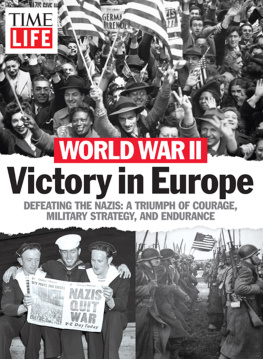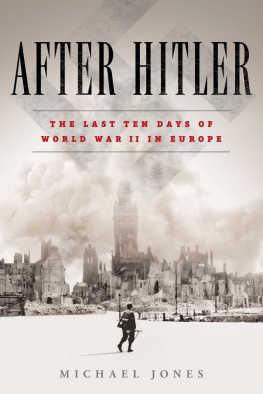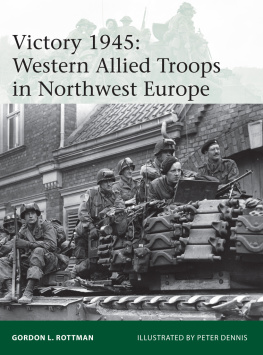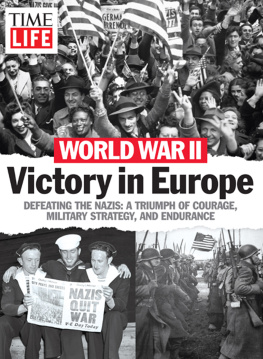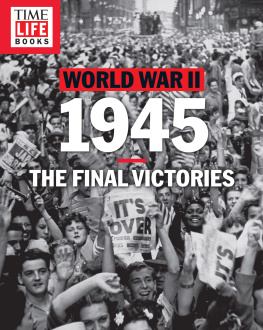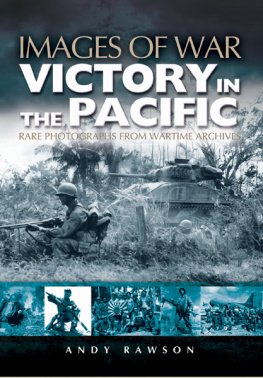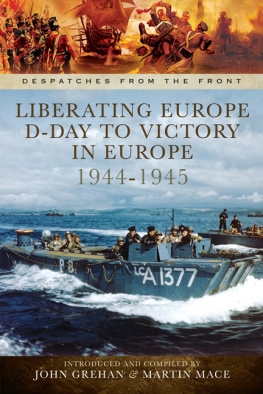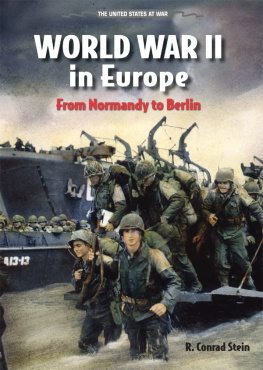CONTENTS
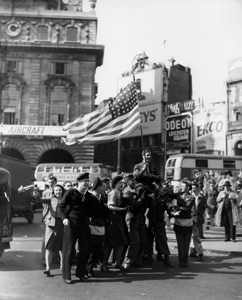
VE DAY 1945 Celebrating Victory in Europe in Piccadilly Circus, London
This is a solemn but glorious hour. General Eisenhower informs me that the forces of Germany have surrendered.... The flags of freedom fly all over Europe.
President Harry Truman, May 8, 1945

WORLD WAR II
Victory In Europe
DEFEATING THE NAZIS:
A TRIUMPH OF COURAGE, MILITARY
STRATEGY, AND ENDURANCE
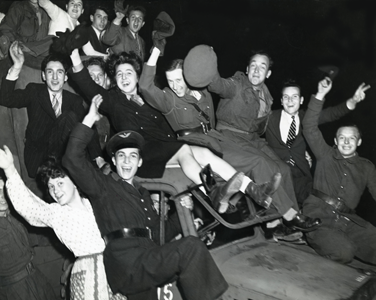
Allied soldiers and French civilians in Paris celebrated victory in Europe, May 8, 1945.
1 THE WESTERN FRONT
AS 1945 DAWNED, MOST GERMANS KNEW THAT THEIR COUNTRY WAS ON THE BRINK OF COLLAPSE. FOR MANY, SURVIVING THE ALLIED ONSLAUGHT WAS THE ONLY THING THAT MATTERED.
The New Year: 1945
AS THE YEAR BEGAN, GERMANY FOUND ITSELF FACING AN INSURMOUNTABLE FOE.
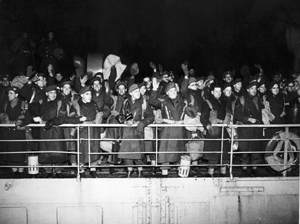
Allied soldiers and sailors arrived in England in 1945 following a tour of duty. They would soon be deployed back to the continent to wage war against Nazi troops.
The Allies had much to cheer about as they celebrated the New Year in January 1945. The invasion of Normandy, France, the previous summer had finally put the Nazis on the run, and the Alliesthe United States, Great Britain, and the Soviet Unioncould see that Germany was on the brink of collapse. Along both the Eastern and Western Fronts of Germany, though, there were brutal battles to wage and to win if the Allies were to succeed. Nazi leader Adolf Hitler believed that his country could still triumph, but many of his generals no longer shared this optimistic view.
In Berlin, Allied bombing raidsAmerican during the day and British at nighttook a heavy toll. People crowded into air-raid shelters and basements. They wrote messages on walls of gutted buildings to sons and husbands returning from the front, letting them know their families were safe, at least for the moment, and living elsewhere. Berliners were short on food, water, and sanitation facilities. Heil Hitler! had been the prevailing everyday greeting and rallying cry; now, Berliners declared, Bleib brig! Survive!
The Russians compounded Germans misery as they advanced north from Hungary and west through East Prussia. The Red Army showed no mercy to captured military or to civilians. Murder, rape, and looting became common tactics of the Soviet forces. Germans faced their untenable situation with a dark humor: Be practical, they quipped at Christmastime. Give a coffin.
Europe 1945

When World War II began, Axis powers lined up behind the Nazis, but by 1945 Germany was surrounded by enemy forces.
Axis Powers: Germany, Italy, Hungary, Romania, Bulgaria, Japan
Allied Powers: United States, Britain, USSR, Australia, Belgium, Canada, China, Denmark, France, Greece, Netherlands, New Zealand, Norway, Poland, South Africa, Yugoslavia, Brazil
Path to the End
As 1945 dawned, six long years of war was ending. The Allies squeezed Germany from two sides, while the fighting in the Pacific became even more savage from all sides.
JANUARY
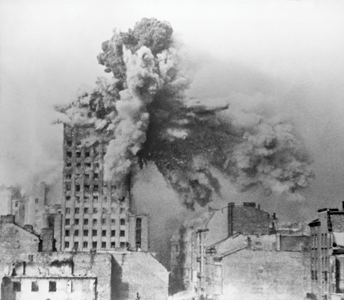
JANUARY 17 Soviet forces liberated Polands capital city, Warsaw, opening the path for the Russians to move south into Germany.
JANUARY 25 The Battle of the Bulge, Hitlers last major offensive on the Western Front, ended in a decisive victory for the Allies.
FEBRUARY
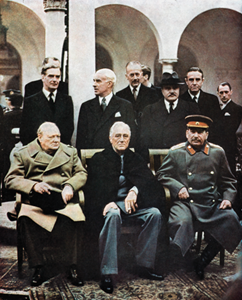
FEBRUARY 4 Allied leaders met at Yalta, a city on the Black Sea, to discuss the surrender of Germany and Japan and to plan for the postwar world.
MARCH
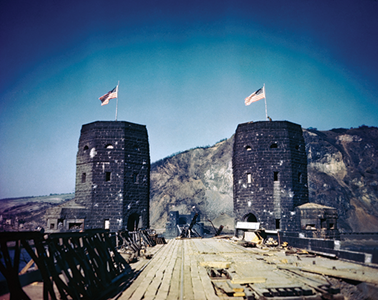
MARCH 7 U.S. troops crossed the Rhine River at Remagen in western Germany, paving the way for soldiers to move into Germanys heartland.
MAY
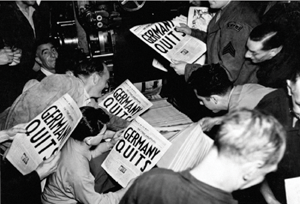
MAY 7 Germany surrendered to the Western Allies.
MAY 9 Germany surrendered to the Soviets, bringing the war in Europe to a close.
The Battle of the Bulge
WITH THE ALLIES SQUEEZING GERMANY FROM THE EAST AND WEST, HITLER PROPOSED A DARING PLAN.
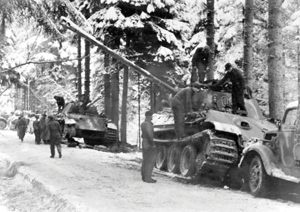
Germanys prized Panzer tanks played a key role in the Battle of the Bulge, December 16, 1944, to January 25, 1945.
In the fall of 1944, Hitler developed a strategy that he hoped would turn the war in the western regions of Europe to his favor and halt the advancing American and British troops. He wanted to seize Antwerp, Belgium, a key port city on the Atlantic coast, which would split the American and British armies fighting in the heavily wooded Ardennes Forest in Belgium. He named the plan Operation Autumn Mist, but it became known as the Battle of the Bulge for the effect the maneuver had on the Allied front lines. If the plan succeeded, Hitler believed American president Franklin Roosevelt and British prime minister Winston Churchill would be forced to the negotiating table.
Hitlers military advisers complained that the scheme was overly ambitious. The Nazi army lacked fuel, tanks, replacement parts, guns, and artillery shells for such an aggressive campaign. In addition, they noted that German soldiers had begun to surrender en masse and that five years of heavy combat had so depleted the rank and file that most of the fighting was being done by young boys and old men. Hitler was unswayed by these arguments and pushed preparations forward.
A cornerstone of the offensive strategy was the creation of a new armored tank group, the Sixth Panzer Army, which was placed in the hands of Josef Sepp Dietrich, Hitlers friend and adviser. The Fifth Panzer Army, led by General Hasso von Manteuffel, who had gained fame for his battle strategies on the Eastern Front and in North Africa, also played an essential role. The offensives success hinged on the element of surprise.
Allied code breakers, however, were one step ahead of the Germans. They intercepted a message sent by the Japanese ambassador in Berlin to government and military officials in Tokyo. The missive described the massing of a million Nazis on the Western Front. The Allies also learned that the Luftwaffe , the German air force, was stockpiling fuel and ammunition in the west and that Nazi officers were seeking soldiers who spoke the American dialect to disrupt Allied troop movement and spread confusion among the ranks.
But instead of providing the Allies with a strategic advantage, this information made Allied commanders overconfident. The deadly battle began early on December 16, 1944, when artillery guns lit up the winter sky in what would be one of the last great German offensives of the war.

